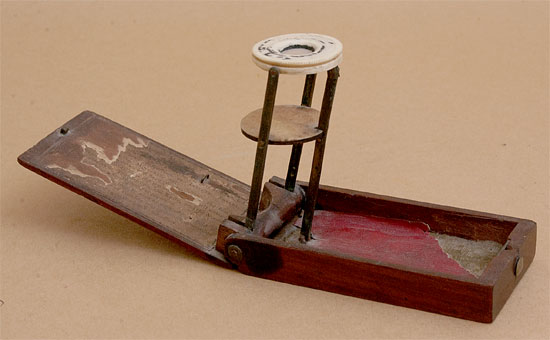 |
|||||
 |
 |
||||
 |
|||||
 |
 |
||||

This instrument is a folding pocked magnifier of approximately 3x magnification built into a mahogany case. There is a single biconvex lens mounted in a bone disk. The top was originally painted black, but most has flaked off. Below the lens is a circular bone sample stage mounted on hinges to the three pillars. This instrument is designed to use ambient illumination so there is no mirror. The lens and stage are a fixed distance away, which is the focal length of the lens. There is no provision for focusing the sample as there was in subsequent, single-pillar models. All Withering folding microscopes are hinged such that when the top is closed the pillars, stage and lens all fold flat. This creates a convenient pocket-size microscope for field work. Folding microscopes were originally equipped with an additional (hand) lens, a forceps, pointer, and lancet. All are missing from this specimen. Glued to the inside of the top are the remains of Withering's instructions for its use. When closed the instrument is 10cm.
The Folding Botanical Microscope designed by William Withering (1741-1799) first described in A Botanical Arrangement of all the Vegetables naturally growing in Great Britain, 2nd Edition (Withering, 1787 vols 1,2; 1792 vol3). Withering designed two styles of botanical microscopes. His earlier style is cylindrical, as exemplified by microscope No. 244 in the Golub Collection. The second type, the folding botanical microscope, is exemplified by this instrument. The folding microscope had several variations over the course of only a few years. All of them had the stage and single magnifying lens attached to the support rods via pins. This allows the microscope to unfold from its flat storage condition to a stacked, open position. The Withering folding microscope had at least four different arrangements. This instrument with its three support rods was the earlier form or second version. Subsequent instruments had only one support rod to give easier access to the sample stage. Unfortunately, this also made the microscope unstable. All folded the stage and lens automatically when the case was closed. This paper describes the two basic styles of Withering microscopes: cylindrical and folding.
Microscope featured 04/2017